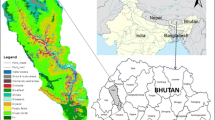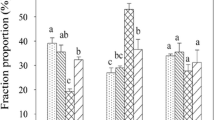Abstract
This study was conducted to explore the effects of topography and land use changes on particulate organic carbon (POC), particulate total nitrogen (PTN), organic carbon (OC) and total nitrogen (TN) associated with different size primary particle fractions in hilly regions of western Iran. Three popular land uses in the selected site including natural forest (NF), disturbed forest (DF) and cultivated land (CL) and three slope gradients (0–10 %, S1, 10–30 %, S2, and 30–50%, S3) were employed as the basis of soil sampling. A total of 99 soil samples were taken from the 0–10 cm surface layer in the whole studied hilly region studied. The results showed that the POC in the forest land use in all slope gradients was considerably more than the deforested and cultivated lands and the highest value was observed at NF-S1 treatment with 9.13%. The values of PTN were significantly higher in the forest land use and in the down slopes (0.5%) than in the deforested and cultivated counterparts and steep slopes (0.09%) except for the CL land use. The C:N ratios in POC fraction were around 17–18 in the forest land and around 23 in the cultivated land. In forest land, the silt-associated OC was highest among the primary particles. The enrichment factor of SOC, EC, was the highest for POC. For the primary particles, EC of both primary fractions of silt and clay showed following trend for selected land uses and slope gradients: CL> DF> NF and S3 > S2> S1. Slope gradient of landscape significantly affected the OC and TN contents associated with the silt and clay particles, whereas higher OC and TN contents were observed in lower positions and the lowest value was measured in the steep slopes. Overall, the results showed that native forest land improves soil organic carbon storage and can reduce the carbon emission and soil erosion especially in the mountainous regions with high rainfall in west of Iran.
Similar content being viewed by others
References
Abbaszadeh Afshar F, Ayoubi S, Jalalian A (2010) Soil redistribution rate and its relationship with soil organic carbon and total nitrogen using 137Cs technique in a cultivated complex hillslope in western Iran. Journal of Environmental Radioactivity 101:629–638.
Ayoubi S, Khormali F, Sharawat KL, Rodrigues de Lima AC (2011) Assessing impact of land use change on soil quality indicators in a loessial soil in Golestan province, Iran. Journal of Agricultural Sciences and Technology 13:727–742.
Balabane M, Plante AF (2004) Aggregation and carbon storage in silty soil using physical fractionation techniques. European Journal of Soil Science 55:415–427.
Baldock JA, Skjemstad JO (2000) Role of the soil matrix and minerals in protecting organic materials against biological attack. Organic Geochemistry 31:697–710.
Bronick GJ, Lal R (2005) Manuring and rotation effect on soil organic carbon concentration for different aggregate size fractions on two soils northeastern Ohio, USA. Soil Tillage and Research 81:239–252.
Cambardella CA, Elliott ET (1993) Methods for physical separation andcharacterization of soil organic matter fractions. Geoderma 56: 449–457.
Carter MR, Gregorich EG, Angers DA et al. (1998) Organic C and N storage and organic C fractions in adjacent cultivated and forest soils of eastern Canada. Soil Tillage and Research 47:253–261.
Celik I (2005) Land use effects on organic matter and physical properties of soil in a southern Mediteranian highland of Turkey. Soil Tillage and Research 83:270–277.
Christensen BT (1996) Carbon in primary and secondary organo-mineral complexes. In: Carter MR, Stewart BA (eds) Structure and organic matter storage in agricultural soils. CRC-Lewis, Boca Raton, FL, USA, pp 97–165.
Christensen BT (1992) Physical fractionation of soil and organic matter in primary particle size and density separates. Advances in Agronomy 20:1–90.
Dang VM, Anderson DW, Farrell RE (2002) Indicators for assessing soil quality after long-term tea cultivation in Northern Mountainous Vietnam. 17th WCSS, Thailand, pp 14–21.
Dengiz O, Kızılkaya R, Göl C, Hepşen Ş (2007) The effects of different topographic positions on soil properties and soil enzymes activities. Asian Journal of Chemistry 19(3): 2295–2306
Doaei N (2008) Physical fractionation of organic matter in adjacent cultivated and pasture soils on a hillslope. MSc thesis of Soil Science. Bu-Ali-Sina University, Iran, p 125.
Evrendilek F, Celik I, Kilic S (2004) Changes in soil organic carbon and other physical soil properties along adjacent Mediterranean forest, grassland, and cropland ecosystems in Turkey. Journal of Arid Environment 59:743–752.
Freixo AA, Machado PLO, dos Santos et al. (2002) Soil organic carbon and fractions of a Rhodic Ferralsol under the influence of tillage and crop rotation systems in southern Brazil. Soil Tillage and Research 64:221–230.
Göl C, Dengiz O (2008) Effect of modifying land cover and longterm agricultural practices on the soil characteristics in native forest-land. Journal of Environmental Biology 29(5): 667–682.
Hoyos N, Comerford NB (2005) Land use and landscape effects on aggregate stability and total carbon of Andisols from the Colombian Andes. Geoderma 129:268–278.
Institute of Soil Science, Academia Sinica (1978) Physical and chemical analysis methods of soil. Shanghai Science Technology, Shanghai, China.
Khormali F, Abtahi A, Stoops G (2006) Micromorphology of calcitic features in highly calcareous soils of Fars Province, Southern Iran. Geoderma 132:31–46.
Khormali F, Shamsi S (2009) Micromorphology and quality attributes of the loess derived soils affected by land use change: A case study in Ghapan watershed, Northern Iran. Journal Mountain Science 6:197–204.
Khormali F, Ajami M, Ayoubi S, Srinivasarao C, Wani SP (2009) Role of deforestation and hillslope position on soil quality attributes of loess-derived soils in Golestan province, Iran. Agriculture Ecosystem Environment 134:178–189.
Kızılkaya R, Dengiz O (2010) Variation of land use and land cover effects on some soil physico-chemical characteristics and coil enzyme activity. Zemdirbyste-Agriculture 97(2): 15–24
Lal R (2004) Agricultural activities and the global carbon cycle. Nutrition Cycling in Agroecosysytem 70:103–116.
Leifed J, Kogel Knabner I (2005) Soil organic matter fractions as early indicators for carbon stock changes under different land use. Geoderma 124: 143–155.
Lorenz KR, Lal R, Shipitalod J (2008) Chemical stabilization of organic carbon pools in particle size fractions in no-till and meadow soils. Biology and Fertility of Soils 44:1043–1051.
Loveland P, Webb J (2003). Is there a critical level of organic matter in the agricultural soils of temperate regions: a review. Soil Tillage and Research 70:1–18.
Magid J, De Nowin KR, Lindedam J et al (2010) Organic matter in size density fractions after 16–50 years of grass ley, cereal crop** and organic amendments. European Journal of Soil Science 61:539–550.
Mendham D S, Heagney EC, Corbeels M et al. (2004) Soil particulate organic matter effects on nitrogen availability after afforestation with Eucalyptus globulus. Soil Biology and Biochemistry 36:1067–1074.
Nardi S, Cocheri G, Dell Agnola G (1996) Biological activity of humus. In: Piccolo, A. (ed) Humic Substances in Terrestrial Ecosystems. Elsevier, Amsterdam, pp 361–406.
Parker JL, Fernandez IJ Rustad LE et al. (2002) Soil organic matter fractionations in experimental forested watersheds. Water Air Soil Pollution 138:101–121.
Puget P, Chenu, C and Balesdent J 1995. Total and young organic matter distribution in aggregates of silty cultivated soils. European Journal of Soil Science 46: 449–459.
Puget P, Lal R, Izaurralde C, et al. (2005) Stock and distribution of total and corn-derived soil organic carbon in aggregate and primary particle fractions for different land use and soil management practices. Soil Science 170:256–279.
Puget P, Lal R (2005) Soil organic carbon and nitrogen in a Mollisol in central Ohio as affected by tillage and land use. Soil Tillage and Research 80:201–213.
Saviozzi A, Levi-Minzi R, Cardelli R (2001) A comparison of soil quality in adjacent cultivated, forest and native grassland soils. Plant Soil 233:251–259.
Schmidt MWI, Kogel-Knaber I (2002) Organic matter in particle size fractions from A and B horizons of a Haplic Alisol. European Journal of Soil Science 53:383–391.
Shi X, **ao L, Rui L et al (2010) Dynamics of soil organic carbon and nitrogen associated with physically separated fractions in a grassland-cultivation sequence in the Qinghai-Tibetan plateau. Biology and Fertility of Soils 46:103–111
Six J, Conant RT, Paul EA (2002) Stabilization mechanisms of soil organic matter: implications for C-saturation of soils. Plant Soil 241:155–176
Soil Survey Staff (2003) Keys to Soil Taxonomy, Ninth edition, NRCS, USDA.
Walkly A, Black IA (1934) An examination of digestion method for determining soil organic matter and a proposed modification of the chromic acid titration. Soil Science 37:29–38.
Wang X, Liu M, Liu S et al. (2006) Fractal Characteristics of Soils under Different Land-use Pattern in the Arid and emiarid Region of the Tibetan Platue, China. Geoderma 134:56–61.
Wilding LP, Smeck NE, Hall GF (1982) Pedogenesis and Soil Taxonomy. II. The soil orders. Developments in Soil Science.
Zinn YL, Lal R, Resck DVS (2005) Texture and organic carbon relations described by a profile pedotransfer function for Brazilian Cerrado soils. Geoderma 127:168–173.
Author information
Authors and Affiliations
Corresponding author
Rights and permissions
About this article
Cite this article
Karchegani, P.M., Ayoubi, S., Mosaddeghi, M.R. et al. Soil organic carbon pools in particle-size fractions as affected by slope gradient and land use change in hilly regions, western Iran. J. Mt. Sci. 9, 87–95 (2012). https://doi.org/10.1007/s11629-012-2211-2
Received:
Accepted:
Published:
Issue Date:
DOI: https://doi.org/10.1007/s11629-012-2211-2




